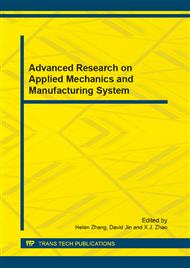[1]
G. J. Siomkos and G. Kurzbard. The hidden crisis in product-harm crisis for Manufacturing system: European Journal of Marketing, Vol. 28(1994), p.30–41.
DOI: 10.1108/03090569410055265
Google Scholar
[2]
S. W. Pruitt and D. R. Peterson. Security price reactions around product recall announcements: Journal of Financial Research, Vol. 9(1986), p.113–122.
DOI: 10.1111/j.1475-6803.1986.tb00441.x
Google Scholar
[3]
D. Laufer and K. Gillespie. Differences in consumer attributions of blame between men and women: The role of perceived vulnerability and empathic concern: Psychology and Marketing, Vol. 21(2004), p.141–157.
DOI: 10.1002/mar.10119
Google Scholar
[4]
K. Cleeren, M. G. Dekimpe, and K. Helsen. Weathering product-harm crises: Journal of the Academy of Marketing Science, Vol. 36(2008), p.262–270.
DOI: 10.1007/s11747-007-0022-8
Google Scholar
[5]
N. Dawar and M. M. Pillutla. Impact of product-harm crises on brand equity: The moderating role of consumer expectations: Journal of Marketing Research, Vol. 37(2000), p.215–226.
DOI: 10.1509/jmkr.37.2.215.18729
Google Scholar
[6]
M. L. McLaughun, M. J. Cody, and H. O'Hair. The Manufacturing system of failure events: Some contextual determinants of accounting behavior: Human Communication Research, Vol. 9(1983), p.208–224.
DOI: 10.1111/j.1468-2958.1983.tb00695.x
Google Scholar
[7]
M. Griffin, B. J. Babin, and J. S. Attaway. An empirical investigation of the impact of negative public publicity on consumer attitudes and intentions: Advances in consumer research, Vol. 18(1991), p.334–341.
Google Scholar
[8]
A. A. Marcus and R. S. Goodman. Victims and shareholders: The dilemmas of presenting corporate policy during a crisis: Academy of Manufacturing system Journal, Vol. 34(1991), p.281–305.
DOI: 10.5465/256443
Google Scholar
[9]
G. Siomkos and P. Shrivastava. Responding to product liability crises: Long Range Planning, Vol. 26(1993), p.72–79.
DOI: 10.1016/0024-6301(93)90079-u
Google Scholar
[10]
Y. Xie and S. Peng. How to repair customer trust after negative publicity: The roles of competence, integrity, beneVolence, and forgiveness: Psychology and Marketing, Vol. 26(2009), p.572–589.
DOI: 10.1002/mar.20289
Google Scholar
[11]
A. K. Smith, R. N. Bolton, and J. Wagner. A model of customer satisfaction with service encounters inVolving failure and recovery: Journal of Marketing Research, Vol. 36(1999), p.356–372.
DOI: 10.1177/002224379903600305
Google Scholar
[12]
K. Schoefer and C. Ennew. The impact of perceived justice on consumers' emotional responses to service complaint experiences: Journal of Services Marketing, Vol. 19(2005), p.261–270.
DOI: 10.1108/08876040510609880
Google Scholar
[13]
J. S. Adams. Inequity in social exchange: Advances in experimental social psychology, Vol. 2(1966), p.267–299.
Google Scholar
[14]
J. Thibaut and L. Walker, Procedural justice: A psychological analysis. NJ(1975): Lawrence Erlbaum Associates Hillsdale.
Google Scholar
[15]
R. J. Bies and J. S. Moag. Interactional justice: Communication criteria of fairness: Research on Negotiation in Organizations, Vol. 1(1986), p.43–55.
Google Scholar
[16]
R. L. Oliver and J. E. Swan. Equity and disconfirmation perceptions as influences on merchant and product satisfaction: The Journal of Consumer Research, Vol. 16(1989), p.372–383.
DOI: 10.1086/209223
Google Scholar
[17]
R. L. Oliver. A cognitive model of the antecedents and consequences of satisfaction decisions: Journal of marketing research, Vol. 17(1980), p.460–469.
DOI: 10.1177/002224378001700405
Google Scholar
[18]
S. Ballester, M. T. M. Sastre, and E. Mullet. Forgivingness and lay conceptualizations of forgiveness: Personality and individual differences, Vol. 47(2009), p.605–609.
DOI: 10.1016/j.paid.2009.05.016
Google Scholar
[19]
R. Thaler. Mental accounting and consumer choice: Marketing science, Vol. 4(1985), p.199–214.
Google Scholar
[20]
E. Walster, E. Berscheid, and G. W. Walster. New directions in equity research: Journal of Personality and Social Psychology, Vol. 25(1973), p.151–176.
DOI: 10.1037/h0033967
Google Scholar
[21]
C. Moorman, G. Zaltman, and R. Deshpande. Relationships between providers and users of market research: the dynamics of trust within and between organizations: Journal of Marketing Research, Vol. 29(1992), p.314–328.
DOI: 10.1177/002224379202900303
Google Scholar
[22]
J. Blodgett and G. Jeffrey. The effects of distributive, procedural, and interactional justice on postcomplaint behavior: Journal of Retailing, Vol. 73(1997), p.185–210.
DOI: 10.1016/s0022-4359(97)90003-8
Google Scholar
[23]
P. Strelan, N. T. Feather, and I. McKee. Justice and forgiveness: Experimental evidence for compatibility: Journal of Experimental Social Psychology, Vol. 44(2008), p.1538–1544.
DOI: 10.1016/j.jesp.2008.07.014
Google Scholar
[24]
C. Fornell and B. Wernerfelt. Defensive marketing strategy by customer complaint Manufacturing system: a theoretical analysis: Journal of Marketing Research, Vol. 24(1987), p.337–346.
DOI: 10.1177/002224378702400401
Google Scholar
[25]
E. J. Finkel, C. E. Rusbult, M. Kumashiro, and P. A. Hannon. Dealing with betrayal in close relationships: Does commitment promote forgiveness?: Journal of Personality and Social Psychology, Vol. 82(2002), p.956–974.
DOI: 10.1037/0022-3514.82.6.956
Google Scholar
[26]
J. C. Anderson and D. W. Gerbing. Structural equation modeling in practice: A review and recommended two-step approach.: Psychological bulletin, Vol. 103(1988), p.411–423.
DOI: 10.1037/0033-2909.103.3.411
Google Scholar


